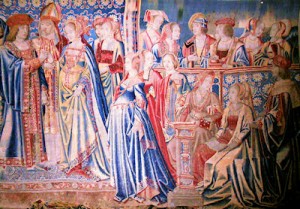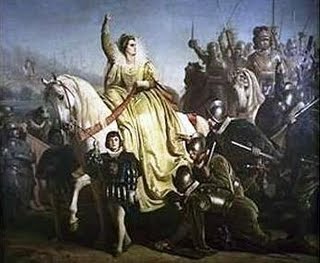Many Tudor marriages were deeply organised affairs with family and parents discussing a young couple's potential marriage. The generally accepted age for marriage during this time was around twelve years for girls and fourteen years of age for boys. However, some marriage alliances were discussed and even organised when the future couple were only young children. Often the young couple did not have a great deal of say in their future marriage. This was especially so for women who were brought up to respect their fathers, brothers and the other men in their life. They were taught to follow their father's wishes and often their own thoughts and feelings did not come into the potential marriage.
Many marriages were organised to secure alliances between families, to build upon a family's wealth or to elevate a family's position within society. Once a marriage had been agreed upon, the parents of the young couple, or elder members of their family, would then go on to discuss exactly what each party would bring to the marriage.
The Church played a huge role in marriage. Marriage was regarded as one of the seven Holy Sacraments. The Church considered that the marriage of a man and woman symbolised the marriage of the Church and God and therefore was unbreakable.
During the Tudor period, a marriage could be as simple as a young couple agreeing to marry one another. There would not be the need for a priest, instead the young couple would clasp hands and then exchange simple vows, such as 'I take you to be my wife' and 'I take you to be my husband', and from this the couple would be married. This could have been the case with Katherine Howard, Henry VIII's fifth wife, and Francis Dereham. It may have been that the young couple exchanged a verbal agreement to marry one another and then referred to each other as husband and wife. They then consummated this agreement and were reported as having "hung by their bellies as two sparrows", i.e. had sex. A union such as this was considered to be valid by the Church.
Since marriage and sex were intractably linked during this period, the Church dictated that a person had to be married before they could participate in sex. Therefore, all the young couple had to do was to agree to be married, preferably before a witness, who could just be a friend, and then they were legally married and able to have sex. Young couples could be getting married to follow their own desires and impulses rather than following the laws of the Church or the wishes of their parents. Potential marriage alliances could be destroyed if a young man or woman married someone that their parents did not want them to marry. Also, children could have been born and the young couple may have had little means to support them. From this the Church decided that they needed stricter laws on how people could get married.
The Church directed that people should not just get married whenever or wherever they wanted and that they certainly should not just get married to get their partner into bed! Clearly, people did not always follow these laws, as there were many cases of men and women sleeping together without being married and even illegitimate children being born. A child that was illegitimate was raised and cared for by the local Parish and the Church was responsible for the child until it was around seven years of age, so naturally the Church pushed for young couples to get married before they had sex so illegitimate births could be avoided.
If a couple wished to get married in a church there were strict rules that they had to follow. There were particular days, such as Holy Days, on which they could not get married. Also, before the marriage, the couple had to attend church for three Holy Days leading up to their marriage. The Priest would ask the couple each Holy Day if they knew of any reason why they could not get married and they of course would have to say 'no'. This idea was to stop any secret marriages happening before the official wedding took place. On the day of the marriage the young couple arrived at the church and the priest would meet them at the front door. The priest then asked the young couple if they would take each other in marriage, to which they each would answer that they did. Then the man would put a ring upon the Bible and it was blessed. The ring was then placed on the fourth finger of the right hand (rather than the left as in today's times). The priest then officially blessed the couple and they were married, right there. After this, the priest would bring the couple into the Church where he would recite a psalm. Then, the young couple were taken to the altar step where they were prayed over. From this, they were then led up to the altar where they knelt and were covered with a veil, and then prayed over. When the veil was removed the couple were pronounced married and were blessed.
The wedding ceremony however did not finish there. The young couple and their family would go and celebrate the wedding, but the priest would return to bless the marriage bed. A marriage was not legal and valid until it had been consummated and thus a priest would bless the marriage bed so that the couple would have sexual intercourse and make the marriage legally binding. This process could, at times, comprise the young woman being conducted to the bed by her ladies (if she were royal) and the man being taken to the bed by his friends and family. The priest would say a prayer and then everyone would leave allowing the couple to have their privacy. The Church believed that women were constantly craving sexual intercourse and that if they did not have sex they could get very sick. Thus it was important that after marriage a man had sexual intercourse with his wife not only to produce children but to keep her under control.
Royal marriages were extremely important during the Tudor period as marriages were often used to build and strengthen international alliances. Marriages were also important in helping to secure the future dynasty. These marriage treaties could take months, or even years, to organise and sometimes even when the marriage had been agreed upon partners could renege on their agreement. This happened when Henry VIII renounced his betrothal to Katherine of Aragon on 27th June 1505, just before his fourteenth birthday. He stated that the marriage had been agreed upon without his consent. Interestingly, though, when his father died Henry VIII took Katherine as his wife.
Marriage was seen as a binding contract and the church saw it as lasting until death, thus the term 'til death do us part'. If a couple wished to break the marriage or to separate they had to take their matter to the Church court, which was concerned with all things spiritual, which marriage was considered to be. In the 14th and 15th centuries at York approximately a third of all the cases brought before the Church were concerned with marriages. To have a marriage annulled the person had to prove that they were insane when they married, or they were too closely related to their new spouse, or that the marriage had never been consummated. A woman could also seek an annulment of her marriage if her husband was impotent. This may sound strange in today’s times but during the Tudor period the purpose of marriage was to produce children. Therefore, if a man could not get his wife pregnant she had the right to find a husband that she could have children with. Although if a woman wanted to use this as a means to have her marriage annulled she had to prove to the court that her husband was impotent!
Although these were the only grounds that a marriage could be legally annulled people in unhappy marriages, like in today's times, did seek other partners. Under some circumstances the Church would also allow the couple to separate and to live apart, but they were forbidden to marry anyone else.
Henry VIII famously broke with Rome when he sought an annulment of his marriage from his first wife Katherine of Aragon. He wished to marry Anne Boleyn but the Pope would not grant him an annulment of his marriage. Desperate to marry Anne, Henry changed the law to put himself as the Supreme Head of the Church of England and thus allowing him to have his first marriage annulled and leaving him free to marry Anne Boleyn.
Marriage during the Tudor period was not simply two people falling in love and deciding to get married. Instead, it was a family affair, often with parents and other family members organising the marriage of two young people. There were also different rules regarding how people could get married during the Tudor period. Today there are many more legal processes and laws regarding marriage.
Sarah Bryson is the author of Mary Boleyn: In a Nutshell. She is a researcher, writer and educator who has a Bachelor of Early Childhood Education with Honours and currently works with children with disabilities. Sarah is passionate about Tudor history and has a deep interest in Mary Boleyn, Anne Boleyn, the reign of Henry VIII and the people of his court. Visiting England in 2009 furthered her passion and when she returned home she started a website, queentohistory.com, and Facebook page about Tudor history. Sarah lives in Australia, enjoys reading, writing, Tudor costume enactment and wishes to return to England one day.
Notes and Sources
- Licence, Amy (2011) "Naughty Tudors: The historical realities of sex outside marriage", his story her story blog, viewed 14 July 2015, http://authorherstorianparent.blogspot.com.au/2011/10/naughty-tudors-historical-realities-of.html.
- Licence, Amy (2012) "Fifty Shades of Lady Jane Grey: Sexual Pleasure, Opportunity and p*rnography in Tudor Times", his story her story blog, viewed 14 July 2015, http://authorherstorianparent.blogspot.com.au/2012/09/fifty-shades-of-lady-jane-grey.html.
- Licence, Amy (2013) "Christopher Marlowe's family and the birth of Modern English midwifery in Elizabethan Canterbury", his story her story blog, viewed 18 July 2015, http://authorherstorianparent.blogspot.com.au/2013/06/christopher-marlowes-family-and-birth.html.
- Medieval Lives: Birth, Marriage and Death 2013, BBC Scotland.
- Tudor Times 2014, Marriage, viewed 14 July 2015, http://tudortimes.co.uk/daily-life/marriage/.




There are lots of inaccuracies here in particular the wedding rings. These were worn on the left hand as it was attached to the artery. Are you from the States?
who asked? smd